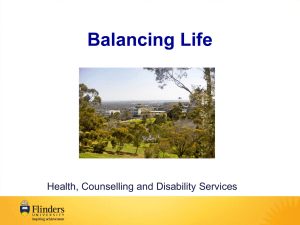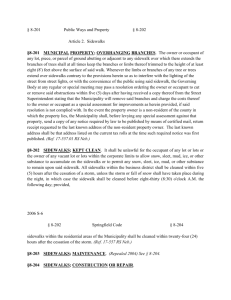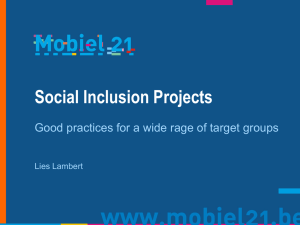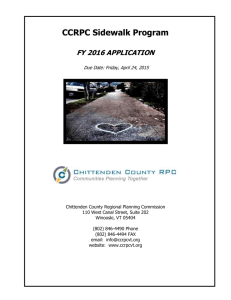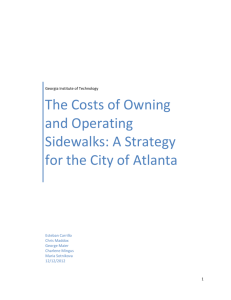Sidewalk Task Force presentation-recommended reforms Sally Flocks
advertisement
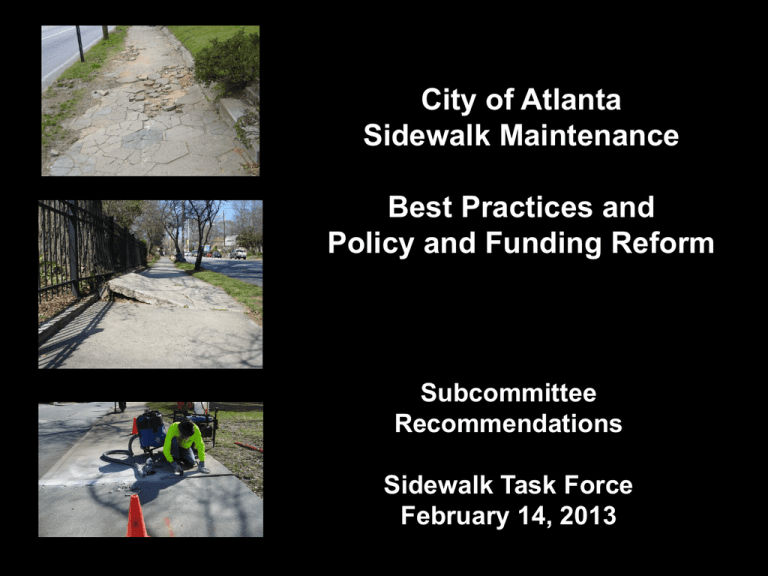
City of Atlanta Sidewalk Maintenance Best Practices and Policy and Funding Reform Subcommittee Recommendations Sidewalk Task Force February 14, 2013 Sidewalk Maintenance: Best Practices and National Trends Create a comprehensive inventory of sidewalk conditions and use a points-based system to prioritize repairs Use a two-pronged approach of repair and replacement. When money is tight, use tax dollars to implement low cost repairs that quickly address tripping hazards. Many programs have moved from assessments on property owners to general financing by the community. Cost-sharing at 25 – 50% or long-term, low-interest loans are common features of effective programs that rely on assessing property owners. Sidewalk maintenance policies have become increasingly attuned to changing demographics and needs of people with disabilities. In 2030, 1 out of 5 people will be over 60. Photo by Dan Burden pedbikeimages.org Public sidewalks are a program of the City that must be accessible to all users. Barden v. Sacramento, 2003. Photo by Dan Burden pedbikeimages.org How do cities pay for sidewalk repair? 50 40 30 20 10 0 Property owner pays full cost City shares cost City pays full cost with property owner Survey of 82 cities in 45 states Donald Shoup, “Fixing Broken Sidewalks” Access, Spring 2010 Recognize barriers to enforcing existing sidewalk policy Lack of community support Atlanta has prioritized sidewalk maintenance so low for decades, it will be difficult to begin again. Lack of community support This is especially true if the City relies on assessments from abutting property owners. Recognize barriers to enforcing existing sidewalk policy High poverty rate Atlanta has a 22.4 % poverty rate. A program relying on property liens as a major funding source is not sustainable. Liens often take years to pay off. Atlanta’s pedestrians deserve more than a “pretend” program Liens can have a severe impact on credit scores. Recognize barriers to using existing sidewalk ordinance to fund sidewalk maintenance Sidewalks are public assets that provide more benefits to the community than to abutting property owners. Recognize barriers to using existing sidewalk ordinance to fund sidewalk maintenance Selective enforcement is inherently unjust “Anne Fauver has been able to secure replacement sidewalks for three streets in Midtown. This is not the start of a program. It is a one-time thing because Anne found a small pot of money. No other neighborhood will have this benefit.” . Recognize barriers to using existing sidewalk ordinance to fund sidewalk maintenance Sidewalks and curbs are often damaged by illegal parking, car wrecks, and other problems beyond the control of property owners. Recognize barriers to using existing sidewalk ordinance to fund sidewalk maintenance On many streets, sidewalks exist on just one side of the street . Why should people on the other side get a free ride with regard to sidewalk maintenance? Recognize and overcome barriers to repairing sidewalks Lack of sidewalk inventories, master Lack of community support plans and weighted formulas needed to prioritize repairs Recognize and overcome barriers to repairing sidewalks Limited funding & staff Lack of community support The annual budget for sidewalk repairs enables Public Works to address less than 1 % of the estimated $152 million backlog of broken sidewalks and curbs. Recommended Reforms Use a proactive inspection program to inventory sidewalk conditions Score points for pedestrian generators and deficiencies when prioritizing projects Use a two-pronged approach of repair and replacement. Repairing sidewalks in a timely manner is much cheaper than replacing them. Most sidewalk tripping hazard thresholds range from ½ to 1 inch Design sidewalks with an eye to maintenance. Plain concrete sidewalks are cheaper to repair and less prone to damage than pavers or bricks. Stamped hexagon sidewalks cost more and are difficult to walk or use wheelchairs on. Make plain concrete the default choice. Tax dollars should cover only the cost of sidewalks built with plain concrete. Additional costs for stamped hexagons or bricks should be paid by abutting property owners or associations. Analyze and make transparent the benefit / cost ratio of the City’s cement plant Does ownership of a cement plant encourage the City to replace sidewalks that could instead be repaired at a much lower cost? Would privatization of sidewalk inspection and repairs reduce maintenance costs? Follow consistent financing procedures . “What is so frustrating is that there are so many blocks around Delaware where the city repaired the sidewalk at no cost to the residents. It is selective billing and that is simply unfair.” Edjuardo Julio Establish a desired timeline for addressing the broken sidewalk , curb or curb ramp backlog and determine how much funding is needed to meet it. Estimated sidewalk and curb backlog: $152 million The City’s sidewalk network of hexagonal concrete and brick pavers are beyond the expected life of 50 years. From 2008 – 2010, the City reconstructed less than 4 percent of the estimated sidewalk backlog and less than 8 percent of the curb backlog. As maintenance is deferred, the cost multiplies by a factor of four to seven. Provide dedicated funding for sidewalk maintenance Allow and provide diverse funding types: . 1. Provide referendum enabling voters to authorize bond funding to pay for addressing the backlog of broken sidewalks and curbs. 2. Following expenditure of bond funds, include $15 million / year allocation for sidewalk maintenance in Atlanta’s annual budget. 3. Allow property owners who choose to pay for sidewalk repairs to do so.
